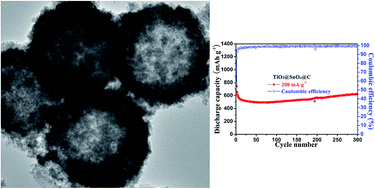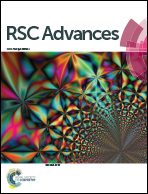Rational fabrication of hybrid structure of SnOx sandwiched between TiO2 and carbon based on the complementary merits of SnOx, TiO2 and carbon, and its improved lithium storage properties†
Abstract
In spite of high-profile theoretical capacity, the practical application of SnO2 or Sn anode materials for lithium-ion batteries is severely impeded by poor electric conductivity and structural instability. Herein, a hybrid structure of SnO2/Sn sandwiched between TiO2 and carbon with rich porosity, good electric conductivity and stable structure, denoted as TiO2@SnOx@C, is fabricated based on the complementary merits of SnO2, TiO2 and carbon anode materials. The TiO2@SnOx@C exhibits a good electrochemical performance when used as anode material for lithium-ion battery, delivering a capacity of 629 mA h g−1 at 200 mA g−1 after 300 cycles. Moreover, a reversible capacity of 490.3 mA h g−1 is obtained at 1000 mA g−1 even after 1000 cycles and is much higher than theoretical capacity of graphite (372 mA h g−1). The effectively complementary and synergic effect among structural stability of TiO2, high theoretical capacity of SnOx, and good conductive and flexible ability of carbon should be responsible for the superior electrochemical performance of TiO2@SnOx@C.


 Please wait while we load your content...
Please wait while we load your content...